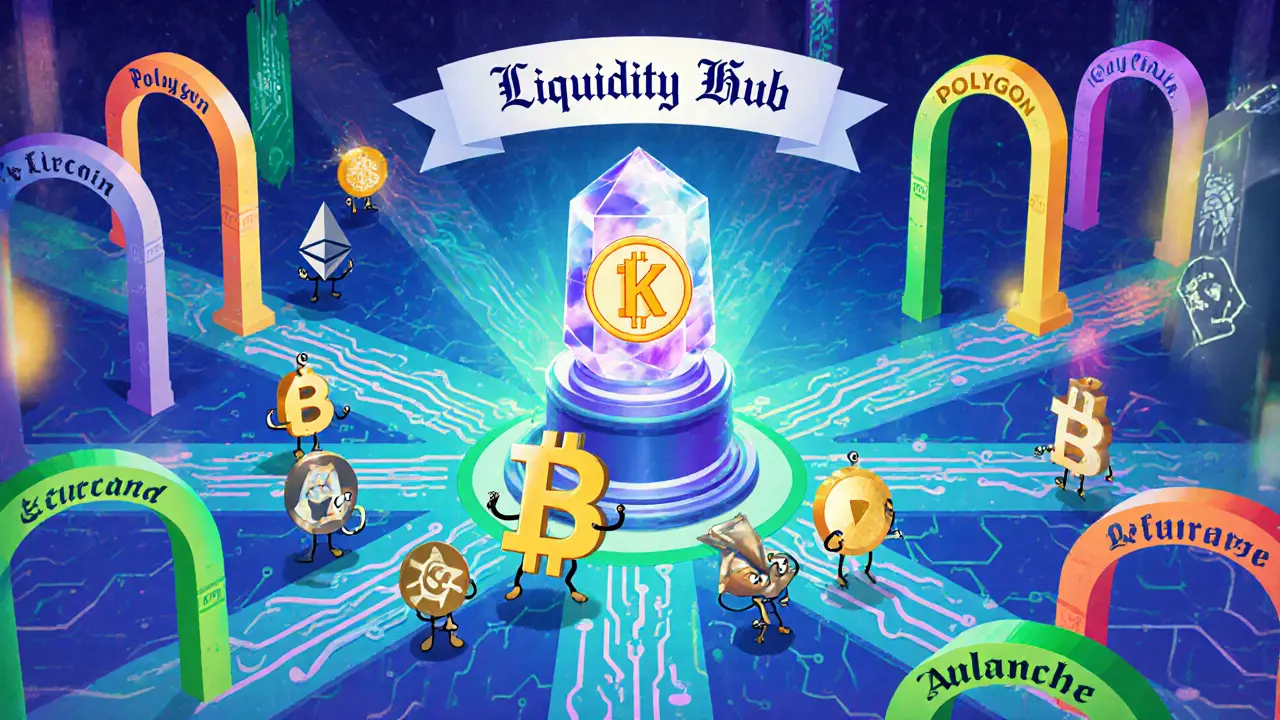 Aug, 10 2025
Aug, 10 2025
KNC Fee Burn Calculator
Fee Burn Impact Calculator
See how much KNC is burned daily from swap fees and the resulting supply reduction.
Estimated Daily Burn
Key Data: 50% of swap fees burned daily. Current circulating supply: 190.49M KNC.
Ever wondered why a tiny token like KNC token shows up in a lot of DeFi dashboards but rarely makes the headlines? The answer lies in how Kyber Network uses it to glue together fragmented liquidity across dozens of chains. In this guide we’ll break down what Kyber Network Crystal v2 (KNC) actually is, how it powers the Kyber ecosystem, and what you should know before buying, staking, or building with it.
What is Kyber Network Crystal v2 (KNC)?
Kyber Network Crystal v2 (KNC) is the native utility and governance token of Kyber Network, a multi‑chain liquidity protocol that aggregates token reserves from over 70 decentralized exchanges. Launched in 2017 and upgraded to version2 in March2021 during the “Katalyst” overhaul, KNC shifted from a simple utility token to the backbone of a community‑run DAO called KyberDAO.
The token lives on Ethereum as an ERC‑20 asset but can be bridged to Polygon, BNB Chain, Avalanche, and other EVM‑compatible networks. Its primary jobs are to enable fee payments, reward liquidity providers, and let token holders vote on protocol upgrades.
How KNC Powers Kyber Network
Kyber’s core value proposition is a "Liquidity Hub" that pulls together price feeds and order books from AMMs like Uniswap, SushiSwap, and professional market makers. When a user or a smart contract requests a swap, Kyber’s Dynamic Market Maker (DMM) scans all connected reserves, picks the best rate, and executes the trade in a single transaction. Because the DMM runs on‑chain, each swap is transparent and settlement is final within seconds.
The fee taken on each swap is split: part goes to liquidity providers, part fuels the KNC buy‑and‑burn program, and a slice funds the KyberDAO treasury. This creates a feedback loop where higher protocol usage translates into a tighter supply of KNC over time.
Token Economics and Burn Mechanism
KNC has a capped supply of 240.53million tokens, with about 190.49million circulating as of October2025. The most distinctive economic feature is the 50% fee‑burn model: every time a swap fee is collected, half of the amount is used to purchase KNC from the open market and then permanently burn it. Over the last year this has removed roughly 4% of the circulating supply, helping to counterbalance inflation from staking rewards.
Staking is another lever of value. To vote on a KyberDAO proposal, you must lock a minimum of ~15k KNC (about $4,200 at the current price). Bigger proposals require larger stakes, which means active participants hold a sizable chunk of the token, aligning incentives between governance and network health.
Cross‑Chain Liquidity and DMM in Action
Unlike single‑chain DEXs, Kyber can aggregate liquidity across multiple blockchains. Suppose you need to swap USDC on Polygon for ETH on Avalanche; Kyber’s cross‑chain bridge pulls the best rates from both networks, executes the two legs, and returns the final token-all within one transaction on your chosen chain. This reduces slippage and gas costs compared to chaining separate swaps manually.
Performance metrics show the DMM can handle 10‑20 trades per second, with settlement completed in a single blockchain transaction. For developers, the API documentation claims an integration window of 3‑5 business days for seasoned Solidity teams, while newcomers typically need 10‑14 days.

Governance via KyberDAO
KyberDAO is the decentralized autonomous organization that decides on fee structures, treasury allocations, and future protocol upgrades. Each KNC holder can become a voter by staking the required amount. Proposals are submitted through the Kyber governance portal, and voting periods last 7‑14 days. As of October2025, roughly 40,920 KNC holders actively participate in governance, shaping key parameters that affect the entire ecosystem.
Because governance is on‑chain, every decision is transparent and auditable. However, the entry barrier (minimum stake) can deter smaller investors from participating, leading to a governance landscape dominated by larger whales.
KNC vs Other Liquidity Tokens
| Feature | KNC (Kyber) | UNI (Uniswap) | SUSHI (SushiSwap) |
|---|---|---|---|
| Primary Role | Liquidity aggregation & DAO governance | Governance of a single‑chain DEX | Governance & liquidity incentives |
| Cross‑chain support | 13+ EVM chains (Ethereum, Polygon, BNB Chain, Avalanche…) | Ethereum & L2s only | Ethereum & L2s only |
| Burn mechanism | 50% of fees used to buy‑and‑burn KNC | No systematic burn | No systematic burn |
| Market cap (Oct2025) | $53.7M | $4.7B | $1.8B |
| Developer adoption | 150+ DeFi projects integrate Kyber | Core DEX, many front‑ends | Wide DeFi usage |
The table shows that KNC’s niche is infrastructure, not retail trading. Its smaller market cap reflects that focus, but the cross‑chain reach and burn model give it a unique value curve.
Key Metrics as of Oct2025
- Total Value Locked (TVL) across Kyber‑connected DEXs: > $25B
- Number of supported tokens: 20,000+
- 24‑hour trading volume for KNC: $13.36M
- Current price: $0.276864 (USD)
- Circulating supply: 190.49M KNC
These numbers illustrate that while KNC isn’t a blockbuster coin, it underpins a massive slice of DeFi liquidity that many other projects rely on.

How to Use or Hold KNC
If you’re a developer, start by signing up on Kyber’s developer portal. The API keys let you fetch real‑time rates, submit swaps, or provide your own liquidity. For everyday investors, the easiest path is to buy KNC on major exchanges (e.g., Binance, Kraken) and then stake it through the Kyber governance dashboard. Remember the minimum stake for a basic proposal is roughly 15k KNC; otherwise you can simply earn a share of the protocol fees by delegating your stake to a larger validator.
Keep an eye on the weekly burn report published by Kyber. Each burn event reduces supply, which historically leads to modest price bumps if demand stays steady.
Common Pitfalls and Tips
1. Ignoring cross‑chain gas costs. Swaps that span chains require bridge fees, which can eat into arbitrage gains. Use Kyber’s gas‑estimator tool before executing large moves.
2. Under‑staking for governance. If you lock just the minimum, your vote weight is tiny compared to large whales. Consider pooling your KNC with a community DAO to amplify influence.
3. Overlooking the burn schedule. The buy‑and‑burn happens daily. Tracking the amount burned gives you insight into supply dynamics.
By staying informed on these aspects, you can make KNC work for you rather than being a passive holder.
Future Outlook
Kyber’s roadmap aims to double the number of supported chains by the end of 2026, adding Solana and Cosmos via cross‑chain messaging protocols. The upcoming "KyberSwap Elastic" AMM, launched in late 2024, introduces dynamic fee tiers that adapt to market volatility, potentially boosting fee revenue-and therefore the size of the burn pool.
Analysts split on price targets: Changelly sees a 2025 average of $0.45, while The Big Whale projects a more modest $0.35. The common thread is that KNC’s upside is tied to broader DeFi liquidity growth and successful developer onboarding.
In short, if you believe multi‑chain liquidity will remain a cornerstone of DeFi, KNC is a token worth watching-especially for those who can participate in governance or provide liquidity to the network.
Frequently Asked Questions
What does KNC stand for?
KNC is short for Kyber Network Crystal, the native token of the Kyber liquidity protocol. The “v2” suffix indicates the token after the 2021 Katalyst upgrade.
How can I earn KNC?
You can earn KNC by providing liquidity to Kyber’s reserves, staking it to secure the KyberDAO, or receiving a share of the protocol fees that are automatically distributed to stakers.
Is KNC a security?
Kyber’s legal team says KNC is designed as a utility and governance token without profit‑sharing features, which currently keeps it out of the SEC’s definition of a security.
What is the KNC burn mechanism?
Half of every swap fee collected by Kyber is used to buy KNC on the open market and then permanently remove (burn) those tokens, reducing total supply over time.
How do I participate in KyberDAO voting?
Stake the required amount of KNC (about 15k for basic proposals) in the Kyber governance portal, submit a proposal or vote on existing ones, and your vote weight will be proportional to the amount you have staked.
Matthew Theuma
August 10, 2025 AT 14:55Reading through the KNC guide feels like watching a quiet lake reflect the sky-calm on the surface, deep underneath 🌊. The burn‑and‑stake model is a neat example of tokenomics trying to self‑balance, though I still wonder how the fee split will evolve as volume's rise. Overall, solid info, but keep an eye on cross‑chain bridge fees! 🤔
Jason Zila
August 14, 2025 AT 02:15The article nails the core mechanics but it glosses over the real risk: if the buy‑and‑burn pool dries up, KNC could face inflation pressure. You need to track the burn reports weekly to gauge supply dynamics. Also, the minimum staking amount feels exclusionary for average users.
Cecilia Cecilia
August 16, 2025 AT 23:42KNC’s utility hinges on its role within the KyberDAO, providing both governance rights and fee distribution. The burn mechanism directly ties network activity to token scarcity.
Schuyler Whetstone
August 19, 2025 AT 23:55Listen up, this whole “KNC is the future” hype is just another buzzword parade. They’re selling a token with a fancy burn chart while ignoring the fact that most of the fees end up in a whale‑controlled treasury. If you’re not ready to hand over 15k KNC just to cast a vote, you’re basically locked out. Stop buying the hype and start reading the finae print, folks.
David Moss
August 22, 2025 AT 18:35Are we really sure that Kyber isn’t secretly funneling a portion of the burn proceeds to an undisclosed off‑chain wallet?; The governance model sounds transparent, yet the minimum stake creates a power‑vacuum for the big players; I’d keep a close eye on the treasury allocations!
Pierce O'Donnell
August 25, 2025 AT 18:49Kyber’s cross‑chain feature sounds impressive, but most traders still prefer native DEXs for speed and lower fees. The added bridge cost often negates any slippage savings.
Vinoth Raja
August 29, 2025 AT 00:35Kyber’s architecture embodies a modular liquidity aggregation paradigm that leverages dynamic market making across heterogeneous EVM ecosystems.
By abstracting reserve sourcing into a unified DMM layer, it reduces the need for end‑users to manually route trades across multiple protocols.
The protocol’s fee split-allocating portions to liquidity providers, the DAO treasury, and the automated buy‑and‑burn engine-creates a self‑reinforcing incentive loop.
Moreover, the 50% burn policy acts as a deflationary lever that counterbalances inflationary pressures from staking emissions.
From a developer standpoint, the SDKs expose concise REST endpoints coupled with Web3‑compatible contract ABIs, streamlining integration pipelines.
Cross‑chain swaps are orchestrated via an on‑chain bridge contract that atomically settles two legs, thereby minimizing state‑transition latency.
Gas optimization is achieved through batching techniques and the utilization of EIP‑1559 fee markets, which is crucial when operating on high‑throughput chains like Polygon.
The governance token KNC, while modest in market cap, accrues voting power proportional to staked volume, aligning stakeholder incentives with protocol health.
Stakeholders must lock roughly 15k KNC for proposal rights, a threshold that filters out frivolous governance spam but also raises centralization concerns.
Liquidity providers are compensated via a proportional share of the swap fee pool, which is dynamically adjusted based on reserve performance metrics.
Kyber’s analytics dashboard provides real‑time insights into reserve depth, slippage indices, and burn volume, enabling data‑driven decision making.
The upcoming Elastic AMM iteration promises adaptive fee tiers that react to market volatility, potentially boosting fee revenue streams.
Such revenue growth directly feeds into the burn mechanism, amplifying the token’s scarcity trajectory.
Regulatory considerations remain nuanced, as KNC is positioned as a utility token, yet its governance scope skirts the boundaries of security classifications.
Investors should therefore monitor both on‑chain activity metrics and off‑chain regulatory developments to assess risk exposure.
In summary, Kyber’s multi‑chain liquidity hub offers solid technical foundations, but its long‑term success hinges on sustained user adoption and effective DAO stewardship.
Kaitlyn Zimmerman
September 1, 2025 AT 00:49If you’re new to staking KNC, start by delegating your tokens to a reputable validator via the Kyber governance portal; this way you earn a portion of the fee revenue without meeting the 15k lock‑up threshold. Also, always double‑check the bridge fee estimator before initiating cross‑chain swaps to avoid surprise costs.
DeAnna Brown
September 3, 2025 AT 22:15Wow, this guide totally demystifies KNC! I love how it breaks down the burn mechanism-finally a token that actually does something with its fees. The cross‑chain capability is a game‑changer, especially for folks like us who hop between Polygon and Avalanche every day. Keep the deep dives coming!
Chris Morano
September 6, 2025 AT 22:29Great overview, thanks for sharing. The explanation of how the DMM works really helped me understand why Kyber can offer lower slippage. I’ll definitely keep an eye on the burn reports to see how supply changes over time.
Ikenna Okonkwo
September 10, 2025 AT 01:29Reading about Kyber’s DAO feels like watching a community garden grow-each participant waters the plot, and the harvest benefits everyone. The balance between staking rewards and token burns is a delicate dance, but when done right it can create sustainable value. Let’s hope the upcoming Elastic AMM adds even more nutrients to the ecosystem.
Bobby Lind
September 13, 2025 AT 07:15Nice.
Jessica Cadis
September 16, 2025 AT 07:29While KNC’s tech stack is solid, the token’s low market cap makes it a risky play for large investors. The governance model rewards whales, which could marginalize the average holder. Proceed with caution.
Katharine Sipio
September 19, 2025 AT 04:55For anyone considering KNC, it is advisable to allocate a modest portion of your portfolio to the token and monitor the weekly burn statistics. A disciplined approach-staking only what you can afford to lock-helps mitigate potential volatility.
Shikhar Shukla
September 22, 2025 AT 05:09The article overlooks the fact that Kyber’s fee‑split mechanism may inadvertently favor liquidity providers at the expense of token holders. Such asymmetry warrants further scrutiny, especially as the protocol scales.
Deepak Kumar
September 25, 2025 AT 08:09Awesome breakdown! If you’re diving into Kyber, start with a small test swap on a testnet to get familiar with the UI, then gradually increase your position. Remember, the community is always ready to help-join the Discord and share your experiences!
Carolyn Pritchett
September 28, 2025 AT 05:35Honestly, the whole KNC hype is just another pump‑and‑dump scheme dressed up as DeFi innovation. The burn numbers are cherry‑picked, and the governance is a playground for insiders. Stay away unless you thrive on losing money.